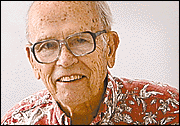Advertisement - Click to support our sponsors.


Hawaii’s World
THIRTY years ago, on March 11, 1970, Gov. John A. Burns, a Catholic, sent the state Legislature the most memorable message ever received from a governor. Hawaii’s abortion law
30 years oldHe began: "House Bill 61, relating to Hawaii's century-old abortion law, is now Act 1 of 1970. The measure became law without my signature.
"I have declined to sign this bill after much study and soul-searching, after receiving competent advice from island and national specialists in law, medicine, theology, human rights and public affairs, and also sincere prayer to the creator named in our nation's Declaration of Independence as the source of our inalienable rights of life, liberty and the pursuit of happiness."
Hawaii thus became the first state to make abortion legal. It was followed the same year by Alaska, New York and Washington. On Jan. 22, 1973, the U.S. Supreme Court ruled that the right to abortion is protected by the Constitution.
Burns wrote: "I have made my decision. I stand by it. It is the decision of the governor of Hawaii, not the private and personal whim of John A. Burns. It reflects my best judgment as governor, made after consultation with the best minds in the state, in regard to what is best for all the people of Hawaii."
He noted "ample evidence that the traffic in illegal abortions is considerable in Hawaii as well as in other jurisdictions" and reasoned that our law should be changed to reflect changed community standards "rather than continue violating an outmoded law."
Act 1 of 1970 now is Section 453-16 of Revised Laws of Hawaii. It permits abortion only by licensed physicians or surgeons or licensed osteopathic physician or surgeons, requires they be performed in hospitals, and requires a woman seeking an abortion to certify being domiciled in Hawaii for at least 90 days. Abortion of a viable fetus remains banned.
It presumably could remain valid even if the U.S. Supreme Court's decision is modified.
In Hawaii recently both abortions and live births have declined, abortions from 6,040 in 1988, the recent peak year, to 4,406 in 1999; live births from a peak of 20,438 in 1990 to 17,081 last year. Bruce S. Anderson, state health director, who favors choice, feels state-sponsored family planning clinics focused on alternatives to abortion have contributed.
LAST year professors from the University of Chicago and Stanford Law School found a strong correlation between reductions in crime with the years when unwanted babies might have reached crime-committing ages. The decline started earlier in the four states, including Hawaii, that legalized abortion in 1970.
The study said a significant number of women who have undergone abortions later choose to bear children.
The stormy Hawaii battle that preceded Burns' dramatic act is chronicled in "Abortion Politics: The Hawaii Experience" by Patricia S. Steinhoff and Milton Diamond, both still professors at the University of Hawaii. Published by the UH Press in 1972, it is out of print but available in libraries.
Endorsements of abortion from some 70 community organizations were obtained by activists led by future state Rep. Joan Hayes. The major media supporter was the Star-Bulletin. The debate, then as now, was between those who believe that life begins at conception versus those who hold it does not begin until a fetus could live outside the womb.
Another Catholic crucial to the enactment was the Senate Judiciary Committee chairman, Vincent Yano. He acted for reasons close to those that moved Burns.
A.A. Smyser is the contributing editor
and former editor of the the Star-Bulletin
His column runs Tuesday and Thursday.